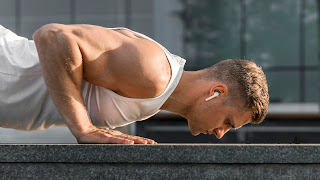Push-Up Technique:
Targets: core, shoulders, arms, and chest
Both the upper body and the core are strengthened by the push-up. There are several methods to accomplish it; beginners may start with the easier varieties, while more seasoned exercisers can use the harder ones. The push-up is a body weight exercise that may also be used for strength training or circuit training.
Learn How to Push Up:
Go down on all fours and position your hands slightly wider than your shoulders to perform a push-up. Keep your elbows slightly bent; don't lock them out. Stretch your legs back until you are erect and balanced. Space your feet hip-width apart. When in this posture, push yourself up using these instructions.
1. Pull your belly button towards your spine to tighten your core and contract your abs.
2. Breathe in as you slowly lower yourself to the ground, bending your elbows until they are at a 90-degree angle.
3. To go back to the starting posture, exhale while tightening your chest muscles and pushing up through your hands.
All the way through the push-up, maintain a tight core. Also, avoid slumping in the midsection or arching your back. Maintain a straight line from head to toe.
Advantages of Push-Ups:
The abdominal muscles used to maintain rigidity during push-ups are the rectus abdominis and the internal and external obliques. Since that it involves several joints, the push-up is a complicated workout.
The muscles engaged in the push-up are the erector spinae of the back, the gluteal or hip muscles, the triceps and biceps of the upper arm, and the deltoids of the shoulders.
In daily life, you frequently have to push against objects like doors and shopping carts. Push-ups provide you with the necessary strength and functional fitness to execute these exercises. Training out the shoulder stabiliser muscles can help prevent rotator cuff problems.
A 2019 study found that those who can do 40 pushups have fewer cardiovascular disease events than people who can only do 10. 4 Push-ups are a test of upper body strength that you may use to determine whether you need to increase your exercise regimen to keep your upper body in tip-top shape.
Can You Burn Fat With Pushups?
Push-ups don't directly burn fat, but resistance training does, which can assist establish the calorie deficit necessary for weight loss. Moreover, gaining muscle might speed up your metabolism. 5 Yet you cannot target-reduce fat, because push-ups do not target-reduce fat on a specific body part.
Several More Push-Up Iterations:
There is a push-up variation for everyone, whether you are a novice who needs to make this activity easier, an advanced person who wants more of a challenge, or someone who wants to better target a particular muscle.
Bench Push-Ups:
It's a modified push-up since you're standing on your knees rather than your toes. Always keep the knees, hips, and shoulders in a straight line. Refrain from bending at the hips.
Push-Ups on an angle:
To make this exercise a little bit simpler, you can also perform incline push-ups. Place yourself some distance from the bench or table. Lift yourself back up after lowering yourself until your elbows are at a 90-degree angle using the same push-up technique as before. Maintain a tight core the entire time you're moving.
Pushups with a stability ball:
Add core stability exercises for increased difficulty and effectiveness. Make sure you can complete about 20 basic push-ups before attempting stability ball push-ups.
Decline Push-Up:
With the feet elevated on a box or bench, decline push-ups are a more challenging variation of the push- up. With only your body weight, you may change the box's height to change the resistance.
Clapping Push-Up:
In this plyometric workout, you push yourself up to the point where your hands leave the ground and you clap while in the air. This workout is not recommended for beginners. If you haven't built up to these, you might very easily get hurt.
Diamond Push-Up:
The triceps brachii are the focus of the diamond push-up version. Making a diamond-shaped pattern on the floor, it is done with your hands clasped together, with the index fingers and thumbs of one hand touching the other. After that, perform push-ups, keeping your elbows close to your sides and your hands in the middle of your chest.
Push-ups with Lat row:
In this variant, the top of each rep includes alternating dumbbell lat rows. This adjustment intensifies the workout, utilises the latissimus dorsi (back) muscles, and engages the core stabilisers.
Instead of pressing against the floor, do a push-up while holding dumbbells in your hands. Pull the weight up to the chest at the top of the exercise before lowering it back to the ground.
Pushups with a medicine ball:
Put one hand on top of a medicine ball and perform a regular push-up. As a result, shoulder stability is improved as the shoulder is worked through a somewhat different range of motion. After completing a rep, roll the medicine ball between each hand to perform an alternate medical-ball push-up, which can aid with balance.
Health and Safety Measures
If you have an injury to your shoulder, wrist, or elbow, you shouldn't perform push-ups. Consult your doctor or physical therapist to find out if this activity is appropriate for your specific situation.
If you want to protect your wrists, you may maintain your hands in a neutral position by placing them on push-up bars or dumbbells.
If you want to protect your wrists, you may maintain your hands in a neutral position by placing them on push-up bars or dumbbells. Push-ups should be stopped if you have shoulder pain or hear clicking in your shoulder.
Repeat as many times as your exercise routine calls for. If you need to pass a fitness test, you may use a few simple tactics to build your strength and endurance so you can do more push-ups.(like the Army Physical Fitness Test).










0 Comments